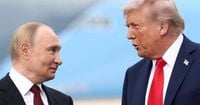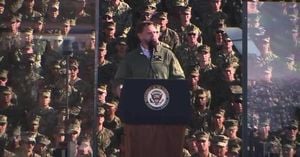United States President Donald Trump and Russian President Vladimir Putin are poised to meet again in Budapest, Hungary, for high-stakes talks aimed at ending the grinding war in Ukraine. The announcement, made by Trump on October 16, 2025, follows a two-hour phone call between the two leaders—their first known conversation since a summit in Alaska earlier this year failed to produce a peace agreement, according to multiple sources including Axios and CNN.
The Budapest summit, expected to take place within two weeks, comes at a moment of heightened tension and shifting strategies on all sides. Trump’s announcement landed just one day before he was set to host Ukrainian President Volodymyr Zelenskyy at the White House, where the Ukrainian leader is expected to press for advanced weaponry—specifically, Tomahawk cruise missiles capable of striking deep inside Russian territory.
"I believe great progress was made with today’s telephone conversation," Trump posted on Truth Social after the call with Putin, signaling optimism about the diplomatic track. He added that senior U.S. and Russian officials would meet the following week to prepare for the summit, with Secretary of State Marco Rubio representing the U.S. and Russian Foreign Minister Sergey Lavrov leading the Russian side. Hungarian Prime Minister Viktor Orbán, whose country will host the talks, declared on social media, "Hungary is the island of PEACE!" as preparations began in earnest.
The choice of Budapest as the meeting site was reportedly Trump’s own proposal, a move that Putin agreed to immediately, according to Russian foreign policy adviser Yuri Ushakov. For Orbán, who has positioned Hungary as a neutral mediator in European conflicts, the summit is a chance to showcase Budapest’s diplomatic clout on the world stage.
But the run-up to these talks has been anything but peaceful. As Trump and Putin spoke, Russian forces unleashed a fresh barrage of hundreds of drones and dozens of missiles across Ukraine, targeting critical infrastructure and plunging eight regions into darkness, according to Ukraine’s national energy operator Ukrenergo. DTEK, Ukraine’s largest private energy company, reported outages in Kyiv and was forced to halt natural gas extraction in the Poltava region after repeated strikes. State-owned Naftogaz said natural gas infrastructure had been damaged for the sixth time this month alone.
Earlier in the week, Russian strikes hit a hospital and a United Nations convoy, injuring 57 people and forcing the evacuation of 50 patients. Ukraine, for its part, has ramped up attacks on Russian targets, including a strike on an oil refinery in Russia’s Saratov region. These tit-for-tat escalations underscore the urgency—and the difficulty—of any potential ceasefire or negotiated settlement.
Against this backdrop, Ukraine’s leadership has shifted its strategy with Washington’s blessing. As reported by CNN, the U.S. recently increased intelligence sharing with Kyiv, providing information on targets deeper inside Russian territory. This marks a significant change: Trump’s administration had previously asked Ukraine to avoid striking Russian energy infrastructure as it pursued peace talks. But after the Alaska summit failed, the U.S. gave Ukraine the green light to resume such attacks, hoping to pressure Moscow back to the negotiating table.
"This is a war that never would have happened had President Trump been President, something President Putin himself acknowledged, and President Trump is trying to get it stopped," a White House official told CNN when asked about the shift in U.S. policy.
For Ukraine, the stakes could hardly be higher. With front lines largely frozen and more than a million casualties on both sides, Kyiv now views targeting Russian energy infrastructure as one of the few remaining ways to produce strategic effects. But these operations are risky and resource-intensive, and Ukrainian officials have repeatedly argued that only with additional long-range weapons—especially Tomahawk missiles—can they truly threaten critical Russian assets and force Putin to negotiate seriously.
Tomahawk cruise missiles, with a range of about 1,600 kilometers (1,000 miles), would put Moscow and other major Russian cities within reach. As Zelenskyy told journalists in Kyiv ahead of his White House visit, the main topics for discussion with Trump would be "air defense and our possibilities with long-range (missiles to put) pressure on Russia."
Trump has been characteristically noncommittal but provocative on the missile question. He told reporters while meeting with Argentina’s President Javier Milei, "I know what [Zelenskyy] has to say. He wants weapons. He would like to have Tomahawks." Asked if he would send them, Trump replied, "We’ll see … I may. I might tell them that if the war is not settled, that we may very well, we may not, but we may do it. Do they [Russia] want Tomahawks going in their direction? I don’t think so."
During his phone call with Putin, Trump said he asked—"in a lighthearted way"—whether Putin would mind if he sent "a couple thousand" Tomahawks to Ukraine. According to Trump, Putin asked him not to, and Trump demurred, saying, "We need Tomahawks for the United States too. We can’t deplete for our country." Putin, for his part, warned that supplying Tomahawks to Ukraine would not change the battlefield situation but would harm U.S.-Russian relations and jeopardize the peace process, according to his adviser Ushakov. The Kremlin has expressed "extreme concern" over the proposal, with Russian officials warning that such a move would be a "whole new level of escalation."
Inside Ukraine, the debate is urgent and ongoing. A Ukrainian official told Axios that Kyiv was still unsure whether Trump would agree to provide Tomahawks, but noted that the possibility alone had already rattled Moscow. "We see and hear that Russia is afraid that the Americans may give us Tomahawks, which is a signal that exactly such pressure may work for peace," Zelenskyy said recently.
Meanwhile, the U.S. has moved ahead with other steps to bolster Ukraine’s defenses, including the sale of 3,350 Extended Range Attack Munition (ERAM) missiles as part of an $825 million arms package. U.S. officials confirmed there are no restrictions on how Ukraine can use these extended-range weapons, further signaling Washington’s willingness to help Kyiv strike targets inside Russia if needed.
Trump’s approach has drawn criticism and support from various quarters. Some argue that his willingness to dangle advanced weaponry over the negotiating table is reckless, risking a dangerous escalation with Russia. Others see it as a necessary show of strength that could finally bring Moscow to terms. Still others note Trump’s efforts to pressure world leaders—including Indian Prime Minister Narendra Modi—to stop buying Russian oil, aiming to choke off a key source of revenue for the Kremlin.
As the world watches, the upcoming Budapest summit will test whether this mix of diplomacy, pressure, and the credible threat of escalation can break the deadlock in Ukraine. For now, the fate of the conflict—and the prospect of peace—hangs in the balance, with all eyes on Trump, Putin, and Zelenskyy as they navigate a perilous and rapidly changing landscape.
The coming weeks will reveal whether talk and tactics can finally bring relief to a war-weary region or simply set the stage for the next round of confrontation.





